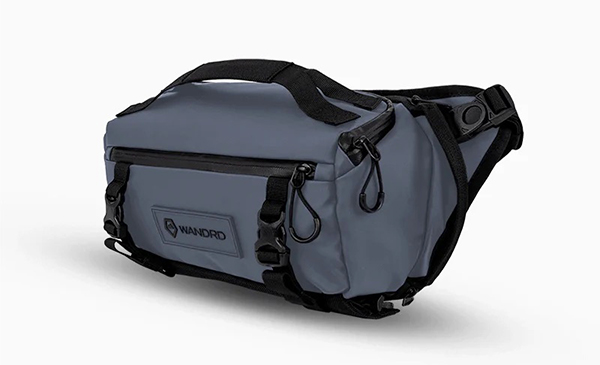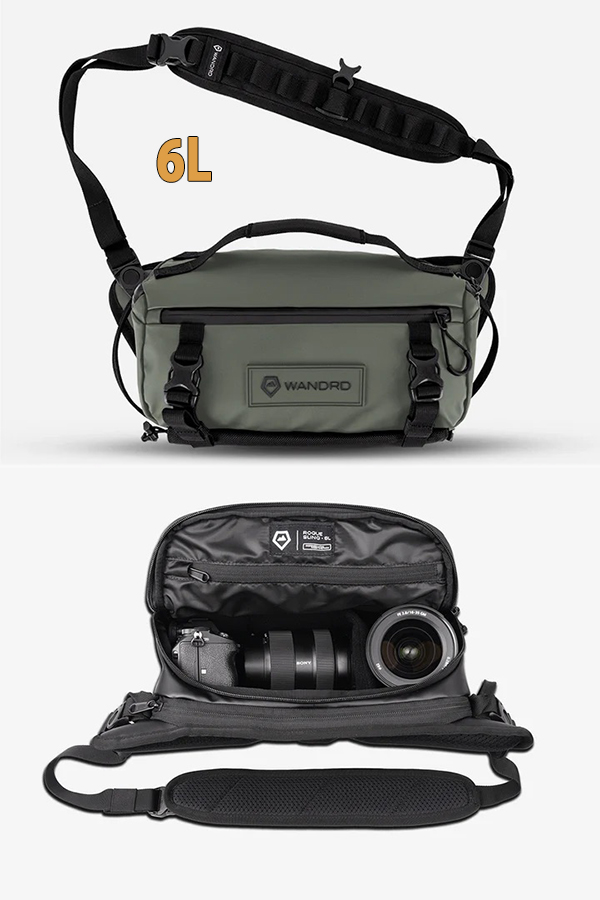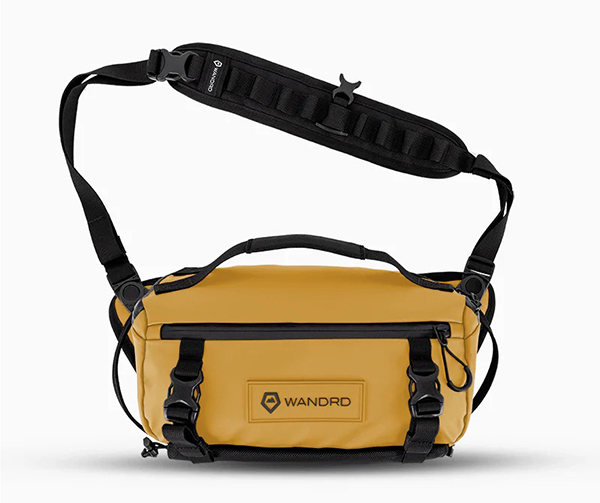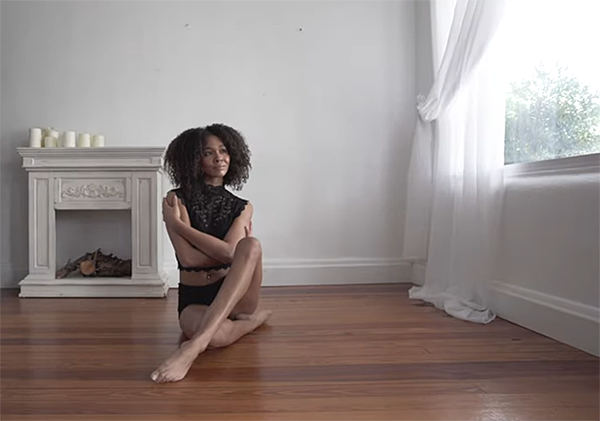WANDRD sent us a pair of Rogue Slings, a yellow mid-size and a green one that’s a little larger, to review. We’re happy to say they have some features that make them unique.
We road tested the WANDRD Rogue Sling 6L and Rogue Sling 9L. The bags are nearly identical except for capacity.
Initially we were attracted to WANDRD bags because of their attractive assortment of colors. Black and natural canvas-beige bags are okay, but muted yellows and greens, etc., are undeniably refreshing. And we’d seen them on Amazon and at B&H, and they appeared to be a tad divergent from the mainstream in other ways besides the multiple color options. WANDRD makes a broad array of what we call “camera carry solutions” but we leaned into the Rogue series because of their wider appeal. Be sure to check WANDRD’s website for other various species.
Available in three sizes (3L, 6L and 9L) and eight colors, WANDRD Rogues Slings are designed in Utah, USA and fabricated in Vietnam. They’re protected by a US Patent and come with a lifetime warranty.
Nowadays, bag manufacturers usually specify the cubic volume of their products in liters (L), and sometimes incorporate the approximate liter volume in the name or model number of the bag. A liter equals 61.02 cubic inches. An object 4 x 4 x 4 inches has a volume of 64 cubic inches. A traditional kitchen/bath tile is roughly 4 inches square; that may help you visualize the sizes mentioned here.
Occasionally bag makers overstate capacities. This specification is very difficult to measure accurately, so this is not necessarily an intentional sleight of hand. The best way to evaluate capacity, naturally, is to handle the bag directly and evaluate how well your gear does or does not fit.

WANDRD is a respected manufacturer of photo bags and backpacks, travel gear, everyday carry bags and duffels, fanny packs, tech bags and many related accessories, including the Worryless locking zipper pulls we assessed and include in this review. Established about 10 years ago and originally launched in a very successful crowdfunding campaign, WANDRD came about for the same reason many camera bag manufacturers were born: because the founders could not find the exact gear-carrying solution they sought so they decided to create one of their own.

Product Highlights – All Rogue Slings
3 sizes: 3L, 6L and 9L (L = Liter)
8 colors: black, blue, yellow, orange, purple, green, tan & gray
Ballistic nylon with weather-resistant coating
YKK zippers
5-Point adjustment system
3 Ways to wear/carry
Ventilated back panel
Expandable tripod/water bottle pocket (on bottom)
3 grab handles
Key clip (see my comments below)
Lifetime warranty (see website for details)

WANDRD Rogue Sling 6L
Volume: 6L
Weight: 1.5 pounds (0.68 kg)
External Dimensions: 7.5 x 12 x 6 inches (19 x 30 x 15cm)
Internal Dimensions: 7 x 11 x 4.25 inches (18 x 28 x11cm)
Strap Length: adjustable 16.5 to 43.5 inches (42 to110cm)
Price: $139
Order directly from WANDRD.

WANDRD Rogue Sling 9L
Volume: 9L
Weight: 1.74 pounds (0.79 kg)
External Dimensions: 8.5 x 13.5 x 7 inches (22 x 34 x 18cm)
Internal Dimensions: 7.75 x 13 x 5 inches (20 x 33 x 13cm)
Strap Length: adjustable 16.5 to 43.5 inches (42 to110cm)
Price: $159
Order directly from WANDRD.
Also available in 3L for $92.65.

Worryless Locking Zipper Pulls
They look like regular zipper pullers, but they lock in a very clever way to make it more difficult for someone to casually pilfer what’s inside your gadget bag. I like ’em. Available in 9 colors, $29 per set of 6 pairs. Order directly from WANDRD. Also available from Amazon.
To see a broad selection of photo products from WANDRD, please visit the Official WANDRD Store on Amazon.

WANDRD Rogue Sling Construction
The exterior fabric has a heavy coating of weather-resistant material and feels slick to the touch. I don’t mind it, but some might. The back—the part that contacts your body—is ventilated for comfort. There is an abundance of carrying handles, and the wide shoulder pad has what appear to be MOLLE loops. MOLLE loops on any strap are nearly worthless, in my experience, except than perhaps hanging a cellphone case. Nonetheless, they are never a negative.
Two adjustable straps grace the front of the bag, suitable to hold a small tripod or nice French baguette. Each strap has a quick-release strap for easy deployment.

WANDRD Rogue Sling Interior
Equipped with the standard repositionable internal dividers, the innards are nicely padded with plush fabric that certainly will not scratch anything. Nicely done. There’s a set of organizer pockets for small things like memory cards as well as a zippered pouch. On the back we find a zippered pouch suitable for a small tablet or the like. On the front, another zippered pouch that hides a key lanyard with a sturdy clip.
Please do not clip your keys to a lanyard that’s tethered to your camera bag. Should someone steal your bag (heaven forbid), why give them your house and/or car keys as well? Put your keys deep in your pocket instead. Bag makers, wake up. Save a dime and skip the key clip. They invite poor practices.
Bottom
The bottom hides an open-ended sleeve that accommodates a water bottle or small tripod. The design is truly ingenious. When not occupied, the sleeve collapses and the bottom of the bag is protected by textured fabric. Frankly, I’d prefer to see the highly weather-resistant plasticky coating, because I often set bags down on wet grass. On either end of the sleeve there’s a strap that secures its cargo. Again, nicely done.

In the Field
I was able to pack my Fujifilm X-T5 with lens plus two more prime lenses in the WANDRD Rogue Sling 6L, and the same outfit plus two more prime lenses and flash in the 9L size. Both bags were comfortable and provided quick and easy access to the gear inside. The shoulder strap was likewise comfortable, but I wish the pad had a more effective nonslip surface (something I often complain about).

Conclusion
If you’re looking for a camera sling bag with sleek, clean contours, this may not be your first choice. But if comfort, excellent security and abundant protection are at the top of your wish list, a WANDRD Rogue Sling bag is a solid choice. Plus, the choice of colorways is staggering. You have 8 options (only 7 colors in the 3L size). The colors are muted—not gaudy or flashy at all. I don’t know of any other purple gadget bags, nor have I ever seen one.
How To Buy A Camera Bag
A few years ago I wrote a straightforward Buyer’s Guide titled, “How To Buy a Camera Bag.” In it I outline the 10 characteristics I consider when I evaluate any camera carry solution. The advice still holds up. You can read the Buyer’s Guide here.
Passionate About Photography?
Join the Shutterbug Community! Sign up for a free account. It’s easy and free. Subscribe to our newsletter (see sign-up form on our homepage) and bookmark Shutterbug as a Favorite on your browser so you can check back often. Visit our Gallery section and spend five minutes or less uploading your best shots once a week or so. You may even become a Shutterbug Photo of the Day photographer. In the Galleries you’ll see the amazing work of thousands of photographers from all over the world; add your own images to our ever-growing collection. It’s a great way to connect with other photographers and share your knowledge and passion for photography.
—Jon Sienkiewicz





























